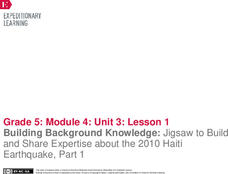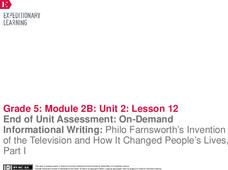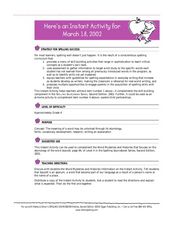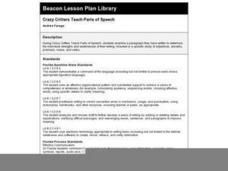Worksheet Web
Suffixes
Add additional meanings to root words! Scholars show what they know about suffixes and root words with a activity that challenges them to create words and complete sentences.
Curated OER
Phineas Gage: Notecard Vocabulary Strategy
Understanding the vocabulary in a text, especially a text like Phineas Gage: A Gruesome but True Story About Brain Science that includes quite a few technical terms, can be the key to understanding the text as a whole. Learners focus on...
Noyce Foundation
Ducklings
The class gets their mean and median all in a row with an assessment task that uses a population of ducklings to work with data displays and measures of central tendency. Pupils create a frequency chart and calculate the mean and median....
EngageNY
Building Background Knowledge: Jigsaw to Build and Share Expertise about the 2010 Haiti Earthquake, Part 1
Using the Jigsaw protocol, scholars study chunks of text from a speech given by former US presidents following a devastating 2010 earthquake in Haiti. As they read the speech in small groups, they build background knowledge and share...
Read Theory
Analogies 3 (Level 7)
Master word analogies with a straightforward exercise. Pupils match word pairs to one another based on the relationships represented in each pair. The worksheet provides bridge sentences that learners fill out as they determine the...
Read Theory
Analogies 2 (Level 6)
Activate analogy skills with a straightforward exercise. Learners complete 10 analogies, using the bridge sentences provided as support while they determine word relationships.
Read Theory
Analogies 2 (Level 7)
Determining the relationships between words is the purpose of this analogy worksheet. Learners puzzle through 10 different analogies by using bridge sentences and types to determine which pairs of words share the same relationships.
Read Theory
Analogies 1 (Level 8)
How many ways can two words be related to one another? Learners practice with 10 analogies that cover a range of relationships. They are provided with bridge types and sentences, which assist pupils in determining the relationships...
Curated OER
Advanced Synonyms and Antonyms- Multiple Choice Verbs 5
Improve word choice and vocabulary skills with a straightforward grammar worksheet. As young readers observe the highlighted words for 12 multiple-choice questions, they choose the best synonym or antonym for each.
BW Walch
Solving Linear Inequalities in Two Variables
Although graphing a linear inequality on the plane is but a few steps added onto the graphing of a linear equation, for many learners the logical leap is quite intimidating. This approachable PowerPoint presentation breaks graphing...
Read Theory
Analogies 1 (Level 6)
Get your middle schoolers up to scratch with analogies using this worksheet. Pupils complete 10 analogies by determining the associations between the words and using the provided bridge sentences.
Read Theory
Analogies 1 (Level 7)
Analogies are a great tool for teaching word relationships. For this worksheet, learners complete 10 analogies using the bridge sentences provided to help them make the correct connections.
Read Theory
Analogies 3 (Level 8)
Engage your learners in analogies! Individuals use the provided bridge sentences and sentence frames to help them determine the relationships between words. They complete a total of 10 analogies.
EngageNY
Mid-Unit Assessment, Part 2: Analyzing an Excerpt from the Narrative
Writing is a craft. Scholars take a mid-unit assessment where they answer questions about the author's purpose and craft in Douglass's narrative. After completing the assessment, pupils look continue with their independent reading text.
EngageNY
Researching Miné Okubo: Gathering Textual Evidence
Scholars read two texts about Miné Okubo’s life. In Riverside’s Miné Okubo and Miné Okubo, readers gather information to write narrative essays describing how Okubo became visible again. The essay serves as part of a performance task.
EngageNY
End of Unit Assessment: On-Demand Informational Writing: Philo Farnsworth’s Invention of the Television and How It Changed People’s Lives, Part I
On-demand isn't just for TV anymore. Writers complete their end of the unit assessment with an on-demand writing task. They read the article Television and answer questions about the gist, vocabulary, and content. They then complete a...
Curated OER
Parts of Speech
In this parts of speech worksheet, students read about the different parts of speech including past, present, future, singular, plural, and more. Students complete a quiz on the parts of speech where they answer 10 multiple choice...
Curated OER
Parts of Similar Triangles
In this parts of similar triangles activity, 10th graders solve and complete 15 different statements related to naming the parts found in similar triangles. First, they identify each definition stated that describes an everyday usage of...
Curated OER
Parts of Speech Matching
In this parts of speech review activity, students match the 8 parts of speech to the appropriate definition by drawing lines to connect the pairs.
Curated OER
Roots
Young scholars are introduced to Latin and Greek roots, prefixes, and suffixes. They are given a lesson on ten root words that students identify the correct meaning of the words. Young scholars design cards that are divided into four parts.
Curated OER
Unlocking Word Meanings
Fourth graders investigate eponyms in the English language. In this eponym lesson, 4th graders participate in a teacher led lesson on the definition of an eponym. They complete a worksheet in which they determine which eponym became part...
Curated OER
School-Home Links: Root Words and Suffixes
In this spelling new words worksheet, learners learn to figure out the meaning of a new word by learning the root word and suffix. Students put the root words and suffixes together to make new words and write those words on the line....
Curated OER
Analyzing Unknown Words
Learners analyze affixes and how they affect word meaning. In this language arts lesson, students use charts to construct and deconstruct words to find meaning.
Curated OER
Crazy Critters Teach Parts of Speech
Middle schoolers create pieces of writing about a creature they have created. They examine the parts of speech and how they are used in their writing to see how they can write more specifically.

























